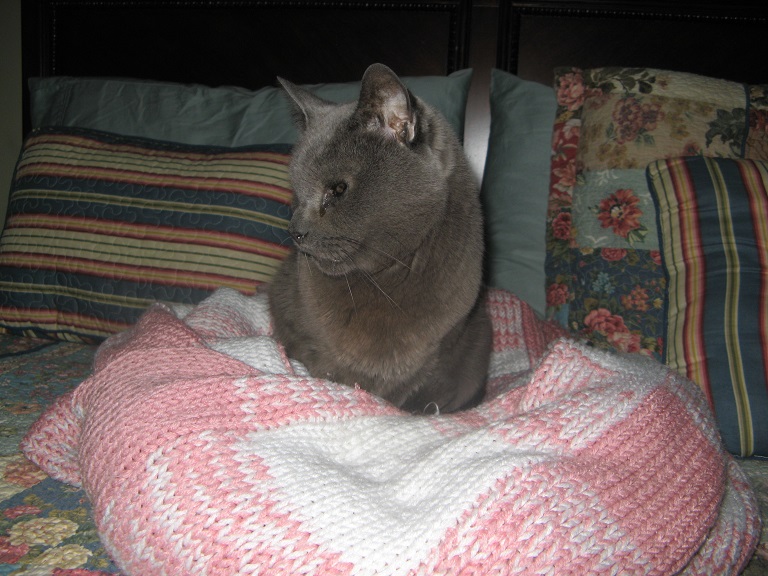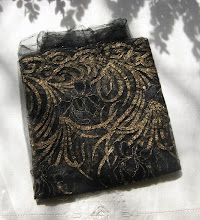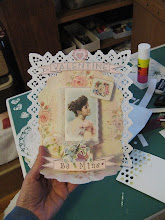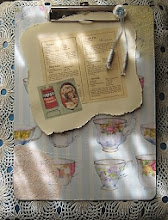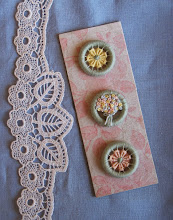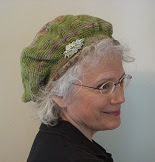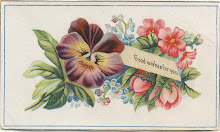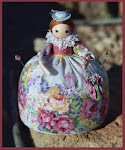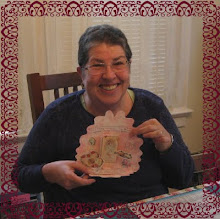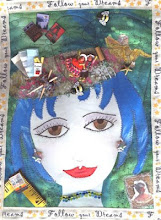 For one of the holiday teas I made many of these cute little felt stocking pins. The ladies loved them! I was touched when, at our tea the following year at Christmas, some of the ladies wore their stocking pins from the year before.
For one of the holiday teas I made many of these cute little felt stocking pins. The ladies loved them! I was touched when, at our tea the following year at Christmas, some of the ladies wore their stocking pins from the year before.The pattern for the stocking pins is below. Trace around the pattern onto doubled felt and cut out. Join the back and front with buttonhole stitch, in a contrasting color of two strands of embroidery floss. Cut a strip of white felt to wrap around the top. Scalloped or pinking shears make a pretty cut. Glue the white felt strip to the stocking using Beacon Fabric-Tac, joining ends of the felt strip at the center back. Glue a 3-hole pin back horizontally on the back of the stocking, on the white strip.

The miniatures that go into the stocking were found at Michaels, near the scrapbook section of the store. You will find a lot of these little holiday things in the months leading up to Christmas.
Join the various miniatures, plus a leaf or two pulled from a fabric flower, using a small piece of fine guage florist wire. (I glued the florist wire to the back of the tiny wrapped presents).

Put a small amount of polyester stuffing in the stocking, to puff it out a bit. Put some Tacky glue on the pre-wired miniatures and insert in the stocking, behind the stuffing. Let dry, wear your cheerful pin during the holidays! Make 30, host a tea at a nursing home and brighten the holidays for the residents there!
It might be fun to add a little embroidered flower to the toe of the stocking. I didn't do that because I was making a lot at one time.
Here is the pattern for the stocking. You will probably have to enlarge or reduce it on your computer or printer. The dimensions of the stocking are 2 - 3/4" high x 2" wide. If it is helpful, the frame around the pattern is 2 - 7/8" high x 2 - 1/8" wide.

These were fun to make, very colorful.
 Enjoy!
Enjoy!+of+IMG_5238+Green+Button,+Purple+Edging+RESIZED.jpg) Here is a sample of one of my beaded button brooches. To see more samples, click on the slide show of beaded buttons (on the right, the beaded cat button picture).
Here is a sample of one of my beaded button brooches. To see more samples, click on the slide show of beaded buttons (on the right, the beaded cat button picture). Buttons old, new, plain, fancy, solid color or patterned -- they all work. The vintage button in the upper left of this photo was recently given to me by a friend. I can't wait to make it into a pin. It's so me, the pink gloved hand, holding the big rhinestone! The bottom left button was recently purchased, at M&J Trimming in NYC. The button on the right is from Africa.
Buttons old, new, plain, fancy, solid color or patterned -- they all work. The vintage button in the upper left of this photo was recently given to me by a friend. I can't wait to make it into a pin. It's so me, the pink gloved hand, holding the big rhinestone! The bottom left button was recently purchased, at M&J Trimming in NYC. The button on the right is from Africa.
 Lastly, if you want to spend a lot of money, you can find reproduction Czech glass buttons online. The glass dragonfly button, below, was purchased at the big bead show in Tucson last February, and it cost about $10. I think the "work in progress" button is funny; I found it at M&J Trimming on my recent trip to New York City. The soft pink button in the center is plastic.
Lastly, if you want to spend a lot of money, you can find reproduction Czech glass buttons online. The glass dragonfly button, below, was purchased at the big bead show in Tucson last February, and it cost about $10. I think the "work in progress" button is funny; I found it at M&J Trimming on my recent trip to New York City. The soft pink button in the center is plastic. Remember, 1" or larger. See you on the 22nd!
Remember, 1" or larger. See you on the 22nd!

 I have paper initials for most of the alphabet (no B, G, M, S, or X's). But I have many, many D's, I's, J's, N's and T's. And if you're name is Yolanda, you are in luck!!
I have paper initials for most of the alphabet (no B, G, M, S, or X's). But I have many, many D's, I's, J's, N's and T's. And if you're name is Yolanda, you are in luck!!  In the next photo, the paper container identifies the contents as "I," which I guess it could be. The narrow vertical bar on the left would not be embroidered over, but would be removed after the embroidery was complete. Is it a "J"?
In the next photo, the paper container identifies the contents as "I," which I guess it could be. The narrow vertical bar on the left would not be embroidered over, but would be removed after the embroidery was complete. Is it a "J"?
 "I" or "J" or "T?"
"I" or "J" or "T?" Maybe this will help:
Maybe this will help:










 These are my kind of colors! Mary modeling her hot pinks and orange wet shawl:
These are my kind of colors! Mary modeling her hot pinks and orange wet shawl:

+shawl+-+WOW!.JPG) A special thank you to Cathy, who helped to find a location for Carolyn's nuno felting class and who took ALL the photos in class. This photo was taken a week later at Cathy's ranch, and so far it's the only dry shawl we have seen!
A special thank you to Cathy, who helped to find a location for Carolyn's nuno felting class and who took ALL the photos in class. This photo was taken a week later at Cathy's ranch, and so far it's the only dry shawl we have seen! 
 Eva's shawl is ready for felting.
Eva's shawl is ready for felting. Dana's artful arrangment of roving and embellishments:
Dana's artful arrangment of roving and embellishments: Dana applying warm, soapy water to the felt 'sandwich' of bubble wrap, silk scarf & roving, and a top layer of bridal veil netting to hold the roving and embellishments in place:
Dana applying warm, soapy water to the felt 'sandwich' of bubble wrap, silk scarf & roving, and a top layer of bridal veil netting to hold the roving and embellishments in place: After wetting the sandwich with soapy water, it is rolled up slowly and fastened with two nylon stockings. Then the rolling process begins. Roll it 200 times, back and forth. Open and check to see how the felting process is going. Roll it up again, and repeat back and forth rolling another 200 times. Repeat as necessary until you can see that the roving has migrated through to the back side of the silk scarf and the roving on the front has started to shrink and felt. Below, Jackie and Janet rolling, rolling, rolling.......
After wetting the sandwich with soapy water, it is rolled up slowly and fastened with two nylon stockings. Then the rolling process begins. Roll it 200 times, back and forth. Open and check to see how the felting process is going. Roll it up again, and repeat back and forth rolling another 200 times. Repeat as necessary until you can see that the roving has migrated through to the back side of the silk scarf and the roving on the front has started to shrink and felt. Below, Jackie and Janet rolling, rolling, rolling....... Janet checks the progress of her nuno felted shawl, below.
Janet checks the progress of her nuno felted shawl, below. 
 Applied in thin layers all around the edge of the silk scarf, underneath:
Applied in thin layers all around the edge of the silk scarf, underneath: And a second layer over the scarf edge on the top of the scarf:
And a second layer over the scarf edge on the top of the scarf: Use very small wisps of roving to hold down mohair locks and other embellishments.
Use very small wisps of roving to hold down mohair locks and other embellishments.
 Workshop participants concentrating.....
Workshop participants concentrating..... 

 Above and below, Carolyn models one of her nuno felted shrugs, front, back, and detail.
Above and below, Carolyn models one of her nuno felted shrugs, front, back, and detail.


 Eva is a natural born model! Here, modeling Carolyn's nuno felted cocoon jacket. Plus a detail of the jacket.
Eva is a natural born model! Here, modeling Carolyn's nuno felted cocoon jacket. Plus a detail of the jacket. 
 Below, Thea's shows the versatility of a nuno scarf. Driving to class, on a cool April morning, the driver window in the van would not go up. We pulled one of Carolyn's scarves out of the back, wrapped it around my head and shoulders, and I was cozy all the way to the workshop (50 miles!).
Below, Thea's shows the versatility of a nuno scarf. Driving to class, on a cool April morning, the driver window in the van would not go up. We pulled one of Carolyn's scarves out of the back, wrapped it around my head and shoulders, and I was cozy all the way to the workshop (50 miles!).+fixed.jpg)

